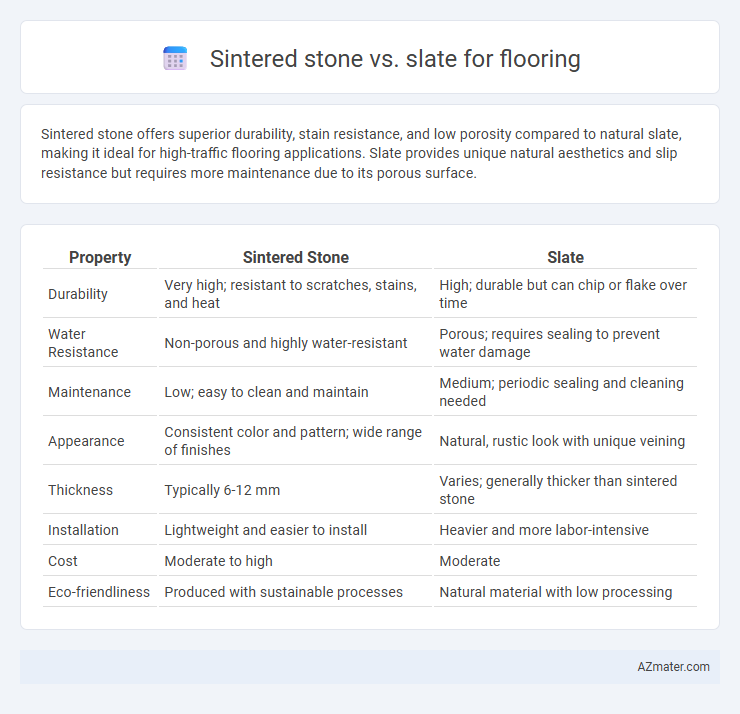Sintered stone offers superior durability, stain resistance, and low porosity compared to natural slate, making it ideal for high-traffic flooring applications. Slate provides unique natural aesthetics and slip resistance but requires more maintenance due to its porous surface.
Table of Comparison
| Property | Sintered Stone | Slate |
|---|---|---|
| Durability | Very high; resistant to scratches, stains, and heat | High; durable but can chip or flake over time |
| Water Resistance | Non-porous and highly water-resistant | Porous; requires sealing to prevent water damage |
| Maintenance | Low; easy to clean and maintain | Medium; periodic sealing and cleaning needed |
| Appearance | Consistent color and pattern; wide range of finishes | Natural, rustic look with unique veining |
| Thickness | Typically 6-12 mm | Varies; generally thicker than sintered stone |
| Installation | Lightweight and easier to install | Heavier and more labor-intensive |
| Cost | Moderate to high | Moderate |
| Eco-friendliness | Produced with sustainable processes | Natural material with low processing |
Introduction: Sintered Stone vs Slate Flooring
Sintered stone offers superior durability and resistance to scratches, stains, and heat compared to natural slate, making it ideal for high-traffic flooring applications. Slate provides a unique, natural aesthetic with variations in texture and color, but it requires more maintenance due to its porous and softer nature. Both materials present distinct benefits for flooring, with sintered stone excelling in longevity and slate preferred for its organic appearance.
What is Sintered Stone? Key Features
Sintered stone is an engineered material composed of natural minerals fused under extreme heat and pressure, creating a dense, durable surface. Key features include its high resistance to scratches, stains, and heat, making it suitable for heavy-use flooring areas. Compared to slate, sintered stone offers uniformity in color and texture, enhanced waterproof properties, and requires less maintenance.
Understanding Natural Slate Flooring
Natural slate flooring offers a unique blend of durability and aesthetic appeal with its distinct layered texture and natural color variations, making it ideal for rustic or contemporary interiors. Unlike sintered stone, which is engineered for enhanced stain and scratch resistance through high temperature and pressure processes, natural slate requires regular sealing to prevent moisture absorption and maintain its longevity. Choosing slate flooring involves balancing its authentic, earthy look with the need for consistent upkeep compared to the low-maintenance nature of sintered stone alternatives.
Aesthetic Differences: Sintered Stone and Slate
Sintered stone offers a sleek, consistent appearance with a wide range of customizable colors and patterns, providing a modern aesthetic ideal for contemporary flooring. Slate, on the other hand, features natural variations in texture and color, delivering a rustic, earthy look with unique veining and mineral specks that enhance its organic charm. The choice between sintered stone and slate for flooring depends on whether a uniform, polished finish or a natural, rugged texture best complements the interior design.
Durability Comparison: Sintered Stone vs Slate
Sintered stone offers superior durability compared to slate due to its resistance to scratches, stains, and impact, making it ideal for high-traffic flooring areas. Slate, while naturally strong and resistant to heat and moisture, is more prone to chipping and requires regular sealing to maintain its longevity. The non-porous nature of sintered stone ensures better performance against wear and environmental factors, providing a longer-lasting flooring solution than traditional slate.
Maintenance Requirements
Sintered stone offers exceptional durability and low maintenance due to its non-porous surface, resisting stains, scratches, and chemicals without the need for sealing. Slate flooring requires regular sealing and careful cleaning to prevent moisture absorption, staining, and potential surface damage from acids or harsh cleaners. Choosing sintered stone reduces long-term upkeep and enhances resilience, making it ideal for high-traffic or moisture-prone areas compared to the more maintenance-intensive slate.
Cost Analysis: Sintered Stone vs Slate Flooring
Sintered stone flooring typically costs between $30 to $60 per square foot, offering a durable and low-maintenance surface compared to slate, which ranges from $15 to $30 per square foot but often requires more frequent sealing and care. The installation cost for sintered stone is generally higher due to its hardness and weight, averaging $10 to $20 per square foot, whereas slate installation falls between $5 and $15 per square foot, influenced by the material's natural cleft texture. Over time, sintered stone's superior resistance to scratches and stains can reduce maintenance expenses, making it a more cost-effective choice for high-traffic areas despite the initial higher investment.
Slip Resistance and Safety Factors
Sintered stone offers superior slip resistance compared to slate due to its dense, non-porous surface and enhanced texture options, reducing the risk of slips and falls in both residential and commercial flooring applications. Slate, while naturally textured, can become slippery when wet because of its porous surface, requiring additional treatments or finishes to improve safety. For environments demanding high slip resistance and durability, sintered stone is often the preferred choice to ensure optimal safety and maintenance.
Environmental Impact and Sustainability
Sintered stone offers superior environmental benefits compared to slate due to its production using natural minerals through a resource-efficient process with minimal waste and low water usage. Slate, while a natural rock with durability, involves quarrying that can lead to significant landscape disruption and higher energy consumption during extraction. Sintered stone's recyclability and resistance to chemicals enhance its sustainability profile, making it a more eco-friendly choice for flooring applications.
Which is Better for Your Flooring Needs?
Sintered stone offers superior durability and resistance to scratches, stains, and UV rays compared to natural slate, making it ideal for high-traffic flooring areas. Slate provides a unique, natural aesthetic with varying textures and colors but requires regular sealing and maintenance to prevent moisture damage and chipping. For long-lasting, low-maintenance flooring with modern design flexibility, sintered stone is generally the better choice, while slate suits those prioritizing natural beauty and traditional appeal.

Infographic: Sintered stone vs Slate for Flooring
 azmater.com
azmater.com